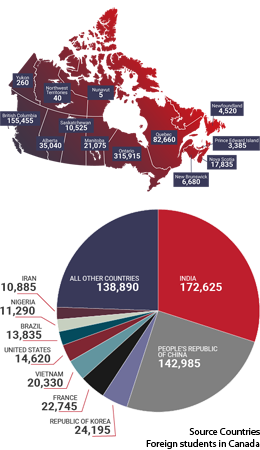New plan to diversify foreign student intake

By Mata Press Service
International students in Canada spent an estimated $21.6 billion on tuition, accommodation and other expenses in 2018 with half of them coming from China and India.
Now under a new five-year plan, Canada wants to diversify where international students come from and where they study in Canada.
A key aim of the new $148-million-strategy is to increase the variety of source countries for international students. It has pledged almost $30 million to diversify recruitment efforts in this domain.
More than 50 per cent of Canada’s international students come from China and India, and they are concentrated in large cities such as Calgary, Toronto and Vancouver.
The strategy’s expanded recruitment efforts will target Mexico, Colombia, Brazil, Vietnam, the Philippines, Indonesia, Thailand, Morocco, Turkey, France and Ukraine.
With a Budget 2019 allocation of $147.9 million over five years followed by $8 million per year of ongoing funding, the new International Education Strategy will, in collaboration with the provinces, territories, associations and institutions, will also:
i) Encourage Canadian students to gain new skills through study and work abroad opportunities in key global markets, especially Asia;
ii) Increase support for Canadian education sector institutions to help grow their export services and explore new opportunities abroad.
“Our new International Education Strategy ensures that Canada will remain among the world’s top destinations for learning,” said James Gordon Carr, Minister of International Trade Diversification.
“This is essential in order for our schools, students and researchers to continue to expand their connections abroad, and to ensure Canadian students benefit from the world of learning beyond our borders,” he said.
“If [students from abroad] choose to immigrate to Canada, they contribute to Canada’s economic success,” Carr said in a statement. “Those who choose to return to their countries become life-long ambassadors for Canada and for Canadian values.”
Another element of Canada’s international education strategy is an investment of nearly $100 million in Canadians studying overseas, focusing on groups that historically have been denied such opportunities such as Indigenous people, low-income and people with disabilities.
Canada’s Minister of Immigration, Refugee and Citizenship, Ahmed Hussen, said that international students are “often ideal candidates for permanent residency,” in a statement from the International Education Strategy.
“The strategy builds on the attributes that have made Canada a destination of choice for international students: strong schools and programs of study in both English and French; welcoming and diverse communities with an enviable quality of life, and opportunities to start careers and pursue permanent residency,” Hussen said.
The report also outlined increased competition from more countries who are recognizing
that international students represent an important source of revenue and human capital.
“The sector has become increasingly competitive. In recent years, both traditional competitors (e.g. Australia, France, Germany, New Zealand, the United Kingdom, the United States) and emerging ones (e.g. China, Malaysia) have invested more in marketing their educational offerings, particularly through the use of digital media. Some of these competitors offer generous scholarships—some even offer free tuition—to attract top talent.
In addition, many traditional source countries for international students are growing the capacity and quality of their own education systems.
Some universities in China, Japan, Singapore and elsewhere in Asia now rank among the world’s best and attract growing numbers of students from abroad. This will likely shift the destination countries preferred by students and also inspire more students to study in their home countries.
A steady increase in the number of schools in Asia and Europe offering programs of study in English further intensifies the competition for international students.
International education can help Canada meet current and emerging labour-market challenges. Canada faces significant medium- and long-term labour shortages, particularly in the highly qualified professional and skilled trades that sustain a modern economy, the report said.
Due in part to the aging of Canada’s population, immigration will increasingly drive net workforce growth.
Within the next decade, for instance, immigration is projected to account for 100% of net growth in the workforce, up from 75% today. International students make excellent candidates for permanent residency: they are relatively young, proficient in at least one official language, have Canadian educational qualifications, and can help address this country’s current and pending labour market needs, particularly for highly skilled workers. Given these advantages, it is not surprising that 53,700 international students became permanent residents of Canada in 2018, contributing as productive and valued members of Canadian society, the report concluded.









